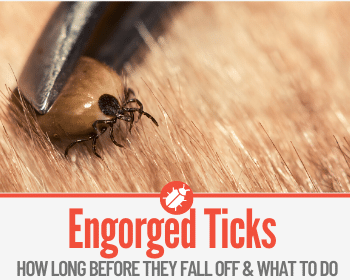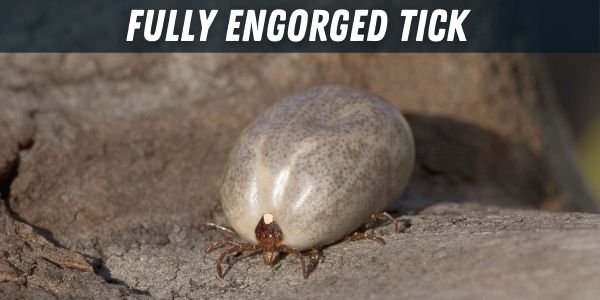how long does it take for a tick to become engorged
 Ticks are a hitchhiker pest found outside, especially in tall grass. They wait for passing warm bodies, and latch on to feed on the blood of animals and people.
Ticks are a hitchhiker pest found outside, especially in tall grass. They wait for passing warm bodies, and latch on to feed on the blood of animals and people.
So how do you know if you or a pet has been bitten by a tick, if so, how long do they take to Engorge?
What do you do if you find a tick in your home or on your dog?
Read on to find out how to handle these blood-sucking arachnids.
Can You Tell How Long a Tick Has Been Attached?
Figuring out roughly how long a tick has been attached is not precise, but it's not complicated.
If the tick in question is not engorged, it's been attached for anywhere from a few moments to two days for nymphs and four days for adults.
Once the tick is engorged, it doesn't always fall off immediately, giving a wider potential time range for engorged ticks.
If the tick is engorged, it has likely been attached for anywhere from two days for nymphs and four days for adults, to as much as two weeks.
How Long Does it Take for a Tick to Become Engorged
If you are wondering how long it takes for a tick to fill up,
For young ticks, called nymphs, it takes two to three days to become engorged.
Adult ticks become engorged after four days to a week, sometimes two weeks.
What Does an Engorged Tick Look Like?
It's easier to spot an engorged tick than one that's not engorged.
When they start out they're tiny, but by the time a tick is engorged and full of your blood they can bloat up to as big as two-thirds of an inch in diameter.

A fully engorged tick is almost round, though not a perfect sphere.
Their color changes as they engorge, also, from a dark brown or black to a paler color.
Because the expand so much, a fully engorged tick is almost shiny.
So as an example, a fully engorged deer tick is a smooth-looking oblong shape, rounded and in color similar to dark silver.
What Happens to a Tick After It's Engorged
Wondering if ticks eventually fall off? The good news is that they do eventually fall off of their host.
The unsettling news is that ticks don't fall off on their own until after they're engorged.
Ticks engorge by feeding on blood. They feed on blood prior to mating.
Male ticks don't feed to engorgement. Only female ticks feed until they become engorged.
Does a tick die after it bites you? Ticks mate after engorging, and after mating, ticks die.
So although engorging doesn't cause the tick's death, the death follows not long after.
For the most part, a tick will release its bite and fall off soon after feeding.
Sometimes, though, they do stay attached for a few extra days.
What Happens if an Un-Engorged Tick Falls Off in My House?
Ticks that have not fed will try to find a host as soon as they can, also you should keep an eye out for other ticks just in case.
If you find a tick in your house that isn't engorged you should pick it up immediately with a tissue.
Ticks are extremely hard to crush and kill, the best method is to pick it up with tissue paper, wrap it inside and burn it.
Another method that is just as effective to dispose of the tick is to pick it up and wrap it in a tight ball of tape (parcel tape/insulation tape etc..).
Make sure it's tightly packed in the tape and cover it with 5-10layers to make a small ball which you can either dispose in your outside garbage bin or flush it down the toilet.
After disposing of, make sure to check yourself, your family, and your pets for any other ticks.
Also, consider Vacuuming the area to be safe, after vacuuming make sure to dispose of the vacuum contents outside.
Be aware, that vacuuming the tick will not kill it, they are incredibly tough!
Make sure to wash your hands thoroughly after handling the tick.
What Happens if an Engorged Tick Falls Off in My House?
If you've found an engorged tick on your floor, what should you do? Well, this means that a tick fed, engorged, and fell off without you noticing it was there beforehand.
The first thing to do if tick that has fed falls off of a host—you, your family, your pets—in your home is the same as with a tick that is not engorged. Kill and Dispose of the tick and check everyone in the house for any other ticks.
Most ticks cannot breed in a house, but just in case the tick that fell off in your house is one of the kind that can survive and thrive inside, you should also take steps to ensure you don't get an infestation.
First, vigorously vacuum all carpeted rooms.
Next, scatter diatomaceous earth (a non-toxic alternative to other methods) by raking it into your carpet and dusting it into corners of hard floored rooms, and vacuum and sweep it up after a week. This will ensure that any existing ticks you might've missed will be killed and cleaned away.
Finally, if you find an engorged tick in your home, it has fed. And in all likelihood, the host it fed on was probably you, a family member, or a pet.
If you can, find the bite and monitor it. If you start to feel sick within the first few weeks after a tick bite, or if the bite shows signs of allergic reaction or infection, see a doctor.
Engorged Ticks on Dogs
Because of their fur, it may be harder to spot a tick on your canine companion. Here's what to look for and what to do if you find it.
What Does a Tick on a Dog Look Like?
An engorged tick on your dog will look like a round, pale, almost shiny little thing stuck to your pet.
A tick that is not yet engorged will be harder to spot, as they are much smaller.
Carefully brush your fingers through your dog's fur, feeling for any bumps in their skin, and check the bumps.
Also do a visual check of your dog's paws, between the toes, and in the ears.
The Ticks are fairly smart and will try to find a place that is very hard for your Dog to reach or scratch to get rid of it.

What Do You Do if You Find a Tick on Your Dog?
With fine-tipped tweezers, grasp the tick as close to the skin as possible. Crushing the tick increases risk of infection, so use careful pressure.
Smoothly pull the tick away from your dog's skin.
Clean the skin with soap and water and/or with vet-approved antibiotic ointment.
Kill the tick by putting it in rubbing alcohol,burn it in a tissue paper, or simply flush it down the toilet after it has been wrapped in a ball of tape to avoid it escaping somewhere.
An alternative and perhaps even better method to remove the tick from your dog is using a piece of thin string (used for sewing)
- Make a tiny loop
- Place it over the engorged tick,so it's right next to the skin of your dog, you want to target the "neck" area for the tick,between it's head and the ticks now very engorged stomach.
- Pull the loop together so it's very tight.
- Now pull on the string, and the tick should pop out, if there's a lot of resistance, try pulling it in small "pulses"
- In Most cases, the tick will be left hanging in the string, however, in rare chance as you pull it, it might pop out and fall on the ground, be ready for this and do this procedure in a well-lit area.
If you're nervous about removing the tick yourself, you can take your dog to the vet instead and they will remove the tick for you.
But what if you've found a tick on your dog, but it was already dead?
The good news is that a dead tick poses much less of a threat.
Simply remove and dispose of it before checking for bites and other ticks, and follow the same steps after that.
What To Do If An Engorged Tick Falls Off My Dog?
First, kill the tick using the methods we've discussed earlier.
Next, check your dog for more ticks as described above, and remove any that you find.
After that, find the bite left by the engorged tick that fell off your dog. Treat that and any other bites you found using the method previously explained.
Finally, monitor your dog. If your dog's behavior or appetites change over the week or so following an engorged tick falling off the dog, call your vet.
how long does it take for a tick to become engorged
Source: https://www.pestshero.com/engorged-ticks-falling-off/
Posted by: gomezsonsen.blogspot.com

0 Response to "how long does it take for a tick to become engorged"
Post a Comment